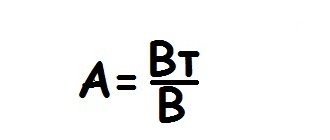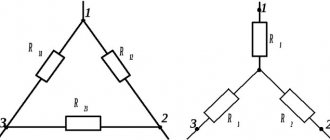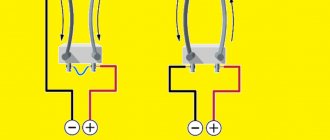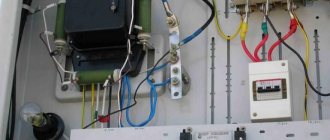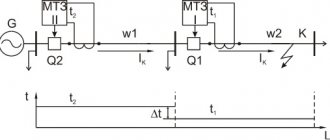Amps and kilowatts are the main characteristics of electricity. Amperes are also called load, and kilowatts are called power. The need to convert these units from one to another arises when you need to understand which protective relay can be installed in an electrical circuit so as not to damage the device connected to it.
The material presented below provides specific examples and calculation formulas for different types of electrical networks and explanations for carrying out such calculations.
If we look at the labeling of most devices that operate from the mains, then the designation of the characteristics of the device usually indicates only the current strength, that is, the value in amperes. But there is also current power, which is measured in kilowatts. And this indicator is especially important when you need to select a protective network device that is installed in the electrical network. The correct choice of an automatic relay allows you to protect devices connected to the network from failure due to peak voltage loads, and the network wires from fire. We will consider the theory and examples of such calculations below.
The need to convert amperes to kilowatts
Power and current are two main characteristics that you need to know in order to correctly install protective devices when working with electrical devices connected to the network. Each device connected to the network must be protected by individually selected protective devices . At the same time, electrical wiring may melt and catch fire if the protective devices are not selected correctly and do not comply with the technical characteristics of the network. After all, all electrical wires that are used have their own current-carrying capacity, which depends on the cross-section of the wire core, and the material from which these cores are made must be taken into account.
Protective devices are usually triggered by voltage surges, which can damage devices connected to the network at that moment. To prevent this from happening, the protection must turn off the branch to which low-power devices are connected. But the relay only indicates the current strength in amperes. And the electrical appliances that we connect to the network are marked with power consumption in watts and kilowatts. The relationship between power and current is very close.
To understand this, you need to understand the terminology and operating principles of the electrical network.
- Usually we consider network voltage , which represents the potential difference, that is, the work that occurs when an electric charge moves from one point in the electrical network to another. The voltage in any electrical network is indicated in volts.
- Current strength , which is measured in amperes, is the number of amperes passing through a conductor in a certain unit of time.
- Current power is the speed at which a charge moves through a conductor and is measured in watts or kilowatts.
Conversion of power to current for a single-phase network
Current calculation is usually performed in the process of selecting a machine that serves a powerful consumer such as a direct-flow water heater.
Based on expressions (1) and (2), the problem is solved in one action. To do this, simply divide the power by the voltage.
The power value is given in the technical description of the device or indicated directly on its body. The voltage is assumed to be 220 V, which creates some calculation margin.
For example, with a power of 3000 W, in accordance with the above rule, we obtain a current of 3000/220 = 13.7 A, which indicates the need to use a 16-amp circuit breaker.
When specifying power in kilowatts, one step is added to the calculation: you must first convert kilowatts to watts, taking into account formula (3).
For example, the heater has a power of 2.8 kW. Then the current calculation is performed as follows:
- W = 2.8*1000 = 2800 W;
- I = W/220 = 12.7 A.
If the power is indicated in VA or kVA, then the calculation does not change, i.e. 3000/220 = 13.7 A (in the second case, we first convert kVA to simple VA, i.e. 3 kVA = 3*1000 = 3000 VA).
The main feature in this case is that, taking into account the typical cosφ = 0.85 for household devices, useful work will be performed by 11.6 A (i.e. 85% of the total current), while the remaining 2.1 A is reactive current, which is uselessly spent on heating the wires.
Unit conversion rules
In the instructions for many devices there are designations in volt-amperes. Their distinction is necessary only for specialists for whom these nuances are important professionally, but for ordinary consumers this is not so important, because the designations used in this case characterize almost the same thing. As for kilowatt/hour and just kilowatt, these are two different quantities that should not be confused under any circumstances.
To determine electrical power through the network current indicator, you can use various tools with which measurements and calculations are made:
- using a tester;
- using clamp meters;
- making calculations on a calculator;
- using special reference books.
Using a tester, we measure the voltage in the electrical network we are interested in, and then use a current clamp to determine the current strength. Having obtained the necessary indicators and applying the existing formula for calculating direct and alternating current, you can calculate the power. We divide the existing result in watts by 1000 and get the number of kilowatts.
Single phase electrical circuit
Basically, all household electrical networks are single-phase networks that use a voltage of 220 volts. The load marking for them is written in kilowatts, and the current strength is in amperes and is designated as AB.
To convert one unit to another, the formula of Ohm's law is used, which states that power ( P ) is equal to current ( I) multiplied by voltage ( U ). That is, the calculation will look like this:
Determination of power by current strength for a single-phase network
The need to perform this procedure most often arises when setting restrictions on the maximum power of an electrical appliance that can be connected to a specific outlet or group of outlets.
If this restriction is violated, the risk of fire increases, and the plastic decorative elements of the outlet may melt due to excess heat generated.
Based on the definitions, which are described in mathematical form by expressions (1) and (2), to find the power, you simply multiply the current by the voltage.
The maximum permissible current is indicated on the outlet marking and for most indoor household products of this type is usually 6 A.
The voltage supplied from the mains to the outlet is 220 - 230 V. Thus, the maximum power is 1.3 kW.
Separately, we point out that the risks of damage to the outlet when connecting an overly powerful device are minimal in properly designed household wiring.
This useful property is provided by:
- installation of automatic machines;
- the use of plugs in powerful electrical appliances that physically cannot be connected to conventional sockets (mechanical interlocking).
A rather popular direct connection of a powerful stationary device (air conditioner, boiler) to the network without the use of sockets can be considered a unique version of mechanical interlocking.
Conclusion
If we return to a single-phase 220V network, then there is a rule that 1 kW is equal to 4.54A, that is, 1A = 0.22 kW or 220V.
As can be seen from the above formulas and calculations, Ohm’s law is used throughout the calculations, where the electric current is the inverse of the resistance. Knowing now all the formulas necessary for calculations, you can independently carry out the necessary actions to select the automatic relay you need to connect, which can be included in the electrical network with the guarantee that all devices connected to it will be safe.
Conclusions and useful video on the topic
About the connection between watts, amperes and volts:
The relationship between amperes and kilovolts is described by Ohm's law. Here there is an inverse proportionality of the strength of the electric current in relation to the resistance. As for voltage, there is a direct dependence of the current on this parameter .
Do you still have questions about the principle of converting Amperes to Kilowatts or want to clarify the nuances of practical calculations? Ask your questions to our experts in the comments block located below the article.
If you have useful information that complements the material presented above, or clarifications, corrections, write your comments and additions below.
Voltage
One definition of electrical voltage describes it as the difference in electrical potential, which is given by the formula:
V = ϕ1 – ϕ2
The concept of voltage was introduced by the German physicist Georg Ohm
in a paper in 1827, which proposed a hydrodynamic model of electric current to explain Ohm’s empirical law discovered by him in 1826:
Tesla Transformer at the Canadian Science and Technology Museum
V = I R,
where V is the potential difference, I is the electric current, and R is the resistance.
Another definition of electric voltage is the ratio of the work done by the field to move a charge in a conductor to the magnitude of the charge.
For this definition, the mathematical expression for voltage is described by the formula:
V=A/q
Voltage, like electrical potential, is measured in volts
(V) and its decimal multiples and submultiples - microvolts (millionths of a volt, µV), millivolts (thousandths of a volt, mV), kilovolts (thousands of volts, kV) and megavolts (millions of volts, MV).
A voltage of 1 V is considered to be the voltage of an electric field that does 1 J of work to move a charge of 1 C. The dimension of voltage in the SI system is defined as
B = kg•m²/(A•s³)
Voltage can be created by various sources: biological objects, technical devices, and even processes occurring in the atmosphere.
Shark lateral line
The elementary cell of any biological object is a cell, which from the point of view of electricity is an electrochemical generator of low voltage. Some organs of living beings, such as the heart, which is a collection of cells, produce higher voltage. It is curious that the most advanced predators of our seas and oceans - sharks of various species - have a hypersensitive voltage sensor called the lateral line organ
, and allowing them to accurately detect their prey by heartbeat. Separately, it is perhaps worth mentioning electric stingrays and eels, which in the process of evolution have developed the ability to create voltages of over 1000 V to defeat prey and repel attacks on themselves!
Although people have been generating electricity, and thereby creating a potential difference (voltage), by rubbing a piece of amber on wool since ancient times, historically the first technical voltage generator was the galvanic cell
.
It was invented by the Italian scientist and doctor Luigi Galvani
, who discovered the phenomenon of potential difference arising when different types of metal and electrolyte come into contact.
This idea was further developed by another Italian physicist Alessandro Volta
.
Volta first placed plates of zinc and copper in acid to produce a continuous electric current, creating the world's first chemical current source. By connecting several of these sources in series, he created a chemical battery, the so-called “Volta Column
,” which made it possible to generate electricity using chemical reactions.
The Voltaic Pole is a replica made by an electrician at the Alessandro Volta Museum in Como, Italy. Canadian Science and Technology Museum in Ottawa
Due to his achievements in creating reliable electrochemical voltage sources, which played a significant role in further research into electrophysical and electrochemical phenomena, the unit of measurement of electrical voltage, the Volt, was named after Volt.
Among the creators of voltage generators, it is necessary to note the Dutch physicist Van der Graaff
, who created
a high-voltage generator
, which is based on the ancient idea of separation of charges using friction - remember amber!
The fathers of modern voltage generators were two remarkable American inventors - Thomas Edison
and
Nikola Tesla
. The latter was an employee at Edison's company, but the two geniuses of electrical engineering disagreed on methods of generating electrical energy. As a result of the subsequent patent war, all of humanity won - Edison's reversible machines found their niche in the form of generators and DC motors, numbering in the billions of devices - just look under the hood of your car or just press the power window button or turn on the blender; and the methods of creating alternating voltage in the form of alternating current generators, devices for converting it in the form of voltage transformers and transmission lines over long distances and countless devices for its application rightfully belong to Tesla. Their number is in no way inferior to the number of Edison’s devices - fans, refrigerators, air conditioners and vacuum cleaners, and a host of other useful devices, the description of which is beyond the scope of this article, operate on Tesla principles.
Housed at the Canadian Science and Technology Museum in Ottawa, this motor-generator, manufactured by Westinghouse in 1904, was used as a reliable power source to generate the exciter magnetic field at a hydroelectric power station in Niagara Falls, NY. NY. The construction of the power plant was led by Nikola Tesla and George Westinghouse
Of course, scientists later created other voltage generators based on other principles, including the use of nuclear decay energy. They are designed to serve as a source of electrical energy for space envoys of humanity into deep space.
But the most powerful source of electrical voltage on Earth, not counting individual scientific installations, is still natural atmospheric processes.
Every second, over 2 thousand thunderstorms rumble on Earth, that is, tens of thousands of natural Van der Graaff generators operate simultaneously, creating voltages of hundreds of kilovolts, discharging currents of tens of kiloamperes in the form of lightning. But, surprisingly, the power of terrestrial generators cannot be compared with the power of electrical storms that occur on the Earth’s sister - Venus - not to mention huge planets like Jupiter and Saturn.
Calculation
Special formulas are used to calculate values. After counting them, all that remains is to insert them into the above formulas. To find the electric current, you need to divide the voltage by the conductor resistance, and to find the power, you need to multiply the voltage by the current force or double the current value by the resistance. It is also possible to divide the double voltage value by the resistance.
Note! Often all the necessary data is written on the box or technical specifications on the manufacturer’s website. Often the information is indicated in kW and can easily be converted into amperage using a converter. Another easy way to determine energy consumption and amperage is to examine the consumer's electric meter or circuit breaker. But in this case, it is necessary to connect only one device to the network.
Relationship between power and current in a three-phase network
The principle of calculating power and current for three-phase networks remains the same. The main difference is a slight modernization of the calculation formulas, which allows us to fully take into account the design features of this type of wiring.
The following expression is traditionally taken as a basic relationship:
W =1.73* U*I, (4)
and U in this case represents the linear voltage, i.e. is U = 380 V.
From expression (4) follows the advantage of using three-phase networks in justified cases: with such a wiring diagram, the current load on individual wires drops to the root of three times with a simultaneous threefold increase in the power supplied to the load.
To prove the last fact, it is enough to note that 380/220 = 1.73, and taking into account the first numerical coefficient we get 1.73 * 1.73 = 3.
The above rules for the connection of currents and power for a three-phase network are formulated in the following form:
- one kW corresponds to 1.5 A of current consumption;
- one ampere corresponds to a power of 0.66 kW.
Let us point out that everything that has been said is true in relation to the case of connecting the load with a so-called star, which is most often encountered in practice.
A triangle connection is also possible, which changes the calculation rules, but it is quite rare and in this situation it is advisable to contact a specialist.
Quick assessment of currents and powers
The extreme simplicity of the initial relations (1) and (2) makes it possible to significantly simplify the execution of current calculations with the additional condition of specifying the power in kilowatts.
The basis for simplifying the calculations is the fact that, taking into account the approximate constancy of voltage in a household single-phase 220-volt network, the conversion of power into current can be performed by multiplying the power by a constant factor.
To determine such a coefficient, it is advisable to use the fact that when setting W in kW, we have a fairly accurate estimate I = W*1000/220 = 4.5*W.
For example, with W = 2.8 kW we get 4.5 * 2.8 = 12.6 A, i.e. calculations are performed faster and much more conveniently compared to “correct” calculations with a slight loss of accuracy.
Similarly, it is equally easy to show that W = 0.22*I kW. It must be remembered that current I is indicated in amperes.
Thus, we get simple rules:
- one kW corresponds to 4.5 A current;
- one ampere corresponds to a power of 0.22 kW.
The latter rule is often rounded down to one ampere equivalent to 0.2 kW.
General information
When climbing a mountain, we do work against the force of gravity
Since we live in the era of electricity, many of us are familiar with the concept of electrical voltage from childhood:
After all, sometimes, while exploring the surrounding reality, we received a considerable shock from him by secretly sticking a couple of fingers into the power socket of electrical devices, secretly from our parents.
Since you are reading this article, nothing particularly terrible has happened to you - it is difficult to live in the era of electricity and not become briefly acquainted with it. With the concept of electric potential,
the situation is somewhat more complicated.
Being a mathematical abstraction, the electric potential is best described by analogy by the action of gravity - the mathematical formulas are absolutely similar, except that negative gravitational charges do not exist, since mass is always positive and at the same time electric charges can be both positive and negative; Electric charges can both attract and repel. As a result of the action of gravitational forces, bodies can only attract, but cannot repel. If we could deal with negative mass, we would master antigravity.
But you just have to push off...
The concept of electric potential plays an important role in describing phenomena related to electricity. Briefly, the concept of electric potential describes the interaction of charges of different or identical signs or groups of such charges.
From the school physics course and from everyday experience, we know that when climbing a mountain, we overcome the force of gravity of the Earth and, thereby, do work against the forces of attraction acting in the potential gravitational field. Since we have some mass, the Earth tries to reduce our potential - to pull us down, which we gladly allow it, rapidly skiing and snowboarding. Similarly, an electric potential field tries to bring like charges closer together and repel like charges.
It follows from this that every electrically charged body tries to lower its potential by getting as close as possible to a powerful source of an electric field of the opposite sign, if no forces prevent this. In the case of charges of the same sign, each electrically charged body tries to lower its potential by moving as far as possible from a powerful source of electric field of the same sign, if no forces prevent this. And if they interfere, then the potential does not change - while you are standing on level ground at the top of the mountain, the force of the Earth’s gravitational attraction is compensated by the reaction of the support and nothing pulls you down, only your weight presses on your skis. But you just have to push off...
Similarly, the field created by some charge acts on any charge, creating the potential for its mechanical movement towards itself or away from itself, depending on the sign of the charge of the interacting bodies.
"Sisyphus", Titian, Prado Museum, Madrid, Spain
